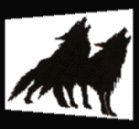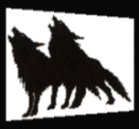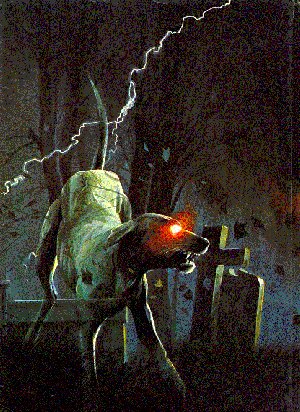|
|
Apparitions Of Black Dogs
|
|
|
|
||
|
|
||
|
|
|
|
|
|
||
|
|
||
|
|
||
|
|
||
|
|
|
The
Theo Brown archive,
University of Exeter |
|
|
|
The
Black Dog of Bungay and Blythburgh
|
|
|
|
The
Black Dog of Uplyme |
|
|
|
The
Black Dog Inn, Black
Dog village |
|
|
The
Black Dog of Kettleness |
|
|
|
Black
Shuck and rock band The
Darkness |
|
1.
Terminology
|
|
|
The
term ‘Black dog’ is used to refer to apparitions of creatures which typically
resemble black dogs, though it is also often used as a generic term for canine
apparitions of other colours and types. The term does not usually include
apparitions of pets however (Brown, 1978; Miller, 1984).
|
|
|
|
Brown
(1958) distinguishes between three separate types of black dog though she
does note that "Obviously these three divisions exist for our convenience merely; there are many overlaps."
(p.179). "A. That which is generally known locally as the Barguest, Shuck, Black Shag, Trash, Skriker, Padfoot, Hooter, and other names. These are not the names of individuals but of an impersonal creature which is distributed over certain areas…This type, which we may call the Barguest type, changes its shape, a thing that no true black dog ever does." (p.176). "B. That which is nearly always known as the Black Dog, is always black, and is always a dog and nothing else…It is always associated with a definite place or ‘beat’ on a road. It is always an individual. Sometimes it is associated with a person or a family…Another personal association is that with witches." (p.178). "C. A third variety of Black Dog, which is rare, is that which appears in a certain locality in conjunction with a calendar cycle." (p.179). So the Type A Black Shuck type is the typical negative and frightening
type of Black Dog, that can change shape and take on diferent forms
and doesn't look much like a normal dog (Norman, 2016, pp. 19-20). The Type B Black Dog tends to look more like a normal dog and tends to be more neutral or positive in its appearance, demeanour and behaviour (Norman, 2016, pp. 21). Picture showing the back cover of 'The Hamlyn Book of Ghosts in Fact and Fiction' by Daniel Farson (1978). |
2. Where are
these apparitions reported?
Black dogs have been widely reported in Great Britain, especially in England, and are generally considered to be mainly a British phenomenon (Bord & Bord, 1985). However, they have also been reported in various forms in Ireland, France, Germany, Austria, Poland, Italy, Croatia, Scandinavia, the United States of America, Canada (Bord & Bord, 1985; Miller, 1984) and Latin America (Burchell, 2007).
The black dog is known by different names in different parts of the British Isles (Bord & Bord, 1985; McEwan, 1986): e.g.
|
|
Norfolk |
Shuck,
Black Shuck, Old Shuck |
|
|
East
Anglia |
Old
Shock, Shucky Dog, Black Shuck, the Shug Monster |
|
|
Suffolk |
Scarfe, Gally-trot, Gallytrot, Galley Trot, Moddey Dhoe |
|
|
Isle
of Man |
Moddey Dhoo, which means "Black Dog" and is pronounced "Mauther Thoo" in Manx Gaelic (Thanks to Ean Radcliffe for this) |
|
|
Lancashire |
Trash,
Guytrash, Skriker |
|
|
Yorkshire |
Barghest, Barghaist, Barguest, Barguest,
Barn-ghaist, Skriker |
|
|
Westmorland |
Cappel |
|
|
Staffordshire |
Padfoot |
|
|
Warwickshire |
Hooter |
|
|
Lincolnshire |
Hairy
Jack |
|
|
Leicestershire |
Shag
Dog |
|
|
Midlands |
Hooter |
|
|
Somerset |
Gurt Dog or ‘great dog’ |
|
|
Wales |
Gwyllgi (dog of darkness) |
|
|
Scotland |
Black
dog known as the Muckle Black Tyke and in Gaelic as
Choin Dubh. |
|
|
Jersey |
Le
Tchan de Bouôlé |
Black dogs are often associated with a particular place or area (Miller, 1984). Black dogs have also been reported at places associated with violent crimes (Miller, 1984). Types of places associated with appearances of black dogs include: roads, crossroads, lanes, footpaths, bridges, gateways, doorways, staircases, boundaries, fields, hedges, green lanes, treasure sites, wayside burials, graves and gallows, wells and trees (Brown, 1958, 1978; Bord & Bord, 1985; Norman, 2016, p. 27). Black dogs are often encountered near water, e.g. the sea, ponds, and bridges over streams or rivers (Bord & Bord, 1985). However, Bord & Bord (1985) note that "there are very few places in Britain where one is very far away from water (except in times of drought!)" (p.98). Bord and Bord (1985) theorised that black dogs might patrol ley lines and dis/appear at various ley points such as churchyards, prehistoric remains and ancient trackways - whether or not ley lines exist or not is not a topic tpo be debated here.
Black dogs are usually seen at night (Bord & Bord, 1985; Norman, 2016, p. 28) though sightings have taken place in daylight (Brown, 1978). They are usually experienced outside, often in lonely rural settings, although a few accounts of encounters inside houses have been reported (Bord & Bord, 1985). In some cases the percipient was making their way home alone at night. Percipients may report that they suddenly become aware of a black dog trotting along beside them (Bord & Bord, 1985; Miller, 1984; Norman, 2016, pp. 28-29).
3.
Characteristics of the apparitions
It has been suggested that the appearance of the apparition might be influenced by the percipients’ psychological disposition and their repertoire of images and symbols (Brown, 1978; Miller, 1984). The main ways that black dog apparitions differ from normal dogs is in terms of their size, their eyes and their behaviour (Bord & Bord, 1985). These features are not always consistent or always present and may vary over time; Norman (2016, pp. 26-28) suggests that nowadays the folklore of Black Dogs is not as widely known as it once was in the 20th century and that the features may be influenced by modern cultural elements such as films and television.
|
|
Colour |
Usually
black, though white, yellow and grey apparitions have also been reported
(Bord & Bord, 1985; Miller,
1984; Norman, 2016, p. 22). |
|
|
Coat |
Shaggy
or curly are terms often used, though glossy, smooth, gleaming, soft
and bristly coats have also been reported (Bord
& Bord, 1985; Brown, 1958; Miller, 1984; Norman, 2016, p.
22). |
|
|
Size |
Often
described as being bigger than an ordinary dog and often about the size
of a calf (Bord & Bord,
1985; Miller, 1984; Norman, 2016, pp. 21-22). |
|
|
Head |
Headless
dogs have been reported in Dartmoor, Cumbria, Sussex, Shropshire, Suffolk,
Devon and Norfolk (Bord & Bord,
1985; Brown, 1958; Farson, 1978). |
|
|
Eyes |
Often
reported as being fiery or flaming, glowing or blazing (usually red)
(Bord & Bord, 1985; Miller,
1984). |
|
|
Mouth |
Foaming
and slavering mouths have been reported (Bord &
Bord, 1985). Sometimes the dogs are reported to
have foul-smelling or vaporous breath (Bord & Bord, 1985). |
|
|
Teeth |
Black
dogs have been reported as having large long teeth and sometimes appear to be
grinning at the percipient (Bord & Bord, 1985). |
|
|
Sounds |
Accompanying
sounds are relatively rare (Norman, 2016, p. 27). Sometimes the apparitions
may be silent, at other times the sound of their feet may be heard (Bord
& Bord, 1985; Norman, 2016, p. 27). Few
black dogs bark or growl and rarer still are those that laugh or speak
(Bord & Bord,
1985; Norman, 2016, p. 25); the Lancashire Skriker
is so-called because of its screams (Bord
& Bord, 1985; Brown, 1958; Rudkin,
1938). Sometimes the sound of chains is reported (Bord
& Bord, 1985; Brown, 1958; Norman, 2016, p. 26). Occasionally
black dogs may be heard or felt but not seen (Bord
& Bord, 1985; Rudkin, 1938). |
|
|
Behaviour |
Most
black dogs either vanish or gradually fade from sight (Bord
& Bord, 1985; Norman, 2016, p. 26). Descriptions
of the vanishing vary; sometimes the apparition vanishes if the percipient’s
attention wanders or if the percipient attempts to touch it; alternatively
the dog appears to sink into the earth or may disappear with a flash
or explosion (Bord & Bord, 1985; Norman,
2016, p. 26). |
4. Accounts of
experiences
The first English account of a black dog probably appeared in the ‘Anglo-Saxon Chronicle’ in 1127 (cited by McEwan, 1986, p.122):
" Let no-one be surprised at the truth of what we are about to relate, for it was common knowledge throughout the whole country that immeddaitely after his arrival [Abbot Henry of Poitou at Abbey of Peterborough] - it was the Sunday when they sing Exurge Quare o, D - many men both saw and heard a great number of huntsmen hunting. The huntsmen were black, huge and hideous, and rode on black horses and on black he-goats and their hounds were jet black with eyes like saucers and horrible. This was seen in the very deer park of the town of Peterborough and in all the woods that stretch from that same town to Stamford, and in the night the monks heard them sounding and winding their horns. Relaible witnesses who kept watch in the night declared that there might well have been as many as twenty or thirty of them winding their horns as near they could tell. This was seen and heard from the time of his arrival all through Lent and right up to Easter."
According to Norman (2016, p. 23), this often cited translation above is not entirely accurate because:
" the word 'saucer' derives from the 14th century and hence cannot be a direct translation from the original document. The correct translation, in fact, reads that the hounds were "black and big-eyed and loathsome"."
The
most famous account encounter is said to have taken place inside St. Mary's
church in Bungay,
Suffolk on Sunday 4th August 1577. The dog then went into the church,
a few miles away, at Blythburgh.
Here is a case which was collected by Miles
(1908) during an investigation of strange animal apparitions that had been
reported in a lane in a village situated approximately halfway between London
and Bristol. The apparitions were believed to be the spirit of a local farmer
who had hanged himself in an outhouse about a century earlier. One of the
villagers gave the following account:
" In the beginning of January, 1905, about half-past seven in the evening, I was walking up from the Halfway [a local inn]. I suddenly saw an animal that seemed to be like a large, black dog appear quite suddenly out of the hedge and run across the road quite close in front of me ; I thought it was the dog belonging to the curate. I was just going to call it to send it home, when it suddenly changed its shape, and turned into a black donkey standing on its hind legs. This creature had two glowing eyes, which appeared to me to be almost as big as saucers. I looked at it in astonishment for a minute or so, when it suddenly vanished. After that I hurried home, for the sight of this creature with the large shining eyes gave me a shock. The evening was a light one for the time of year." (Miles, 1908, p.259).
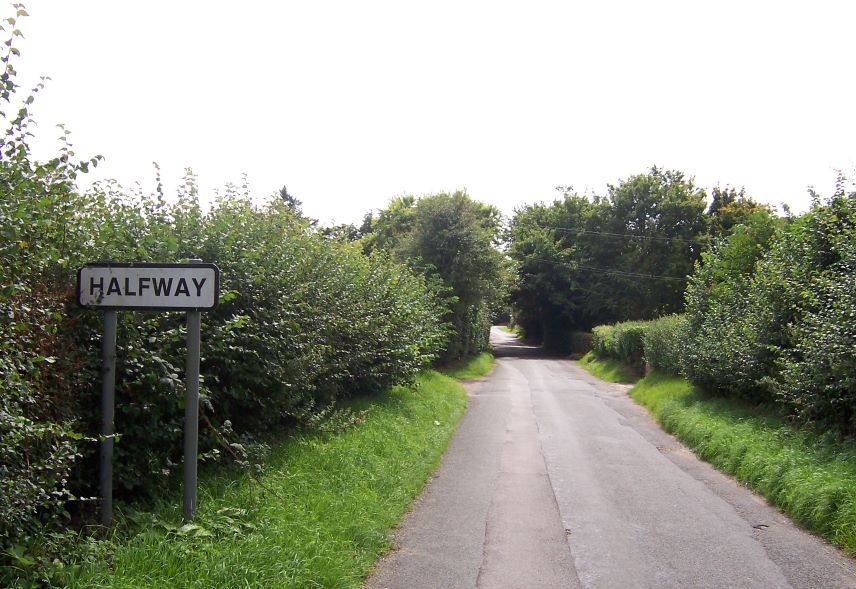 |
Here is a case cited by McEwan (1986, p. 132) involving a four-year-old girl who had been evacuated during WWII:
"My encounter took place one late afternoon in summer, when I had been sent to bed but was far from sleepy. I was sitting at the end of the big brass bedstead, playing with the ornamental knobs and looking out of the window, when I was aware of a scratching noise, and an enormous black dog had walked from the direction of the fireplace on my left. It passed round the end of the bed, between me and the window, round the other corner of the bed, towards the door. As the dog passed between me and the window, it swung its head round to stare at me - it had very large, very red eyes, which glowed from inside as if lit up, and as it looked at me I was quite terrified, and very much aware of the creature’s breath, which was warm and strong as a gust of wind. The animal must have been very tall, as I was sitting on the old-fashioned bedstead, which was quite high, and our eyes were level. Funnily enough, by the time it reached the door it had vanished. I assure you that I was wide awake at the time and sat for quite some long time wondering about what I had seen, and to be truthful, too scared to get into bed, under the covers, and go to sleep. I clearly remember my mother and our host, sitting in the garden in the late sun, talking, and hearing the ringing of the bell on the weekly fried-fish van from Birmingham as it went through the village! I am sure I was not dreaming, and have never forgotten the experience, remembering to the last detail how I felt, what the dog looked like, etc."
Here is an account of an experience that I had as a small child, aged probably 3-5 years, when I was living in Spalding in Lincolnshire, England. I wrote this account as part of a school topic book when I was aged 9-10 years of age:
"The year was about 1974. I had been in bed a couple of hours. I awoke to hear a patter of feet. I looked up thinking it was my dog, but to my terror I saw a massive black animal probably with horns, but perhaps ears, galloping along the landing towards my bedroom. I tried to scream but I found it impossible. The creatures eyes were bright yellow and as big as saucers. The animal got to my bedroom door and then vanished as quick as it has appeared. I then managed to scream and my mum came in to calm me down. She said it was a reflection of car headlights what I thought was a ghost. I believed this until a few years later when I was reading a local paper which had an article about a haunted council house which was inhabited by a poltergeist. A variety of objects were hurled at the family's baby child. The father claimed that a black dog rushed at him and then disappeared. He also claimed that a black goat had been seen running around the house. I also thought I saw a ghostly black goat on the landing of my old house. After reading this article I was convinced that what I thought had happened a few years back had most probably happened."
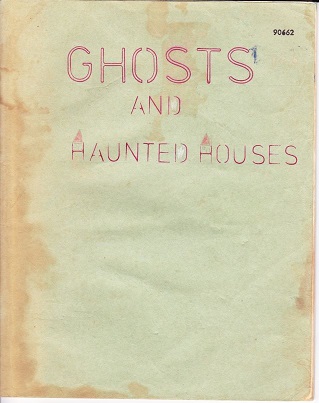 |
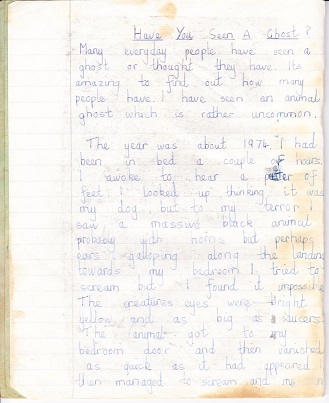 |
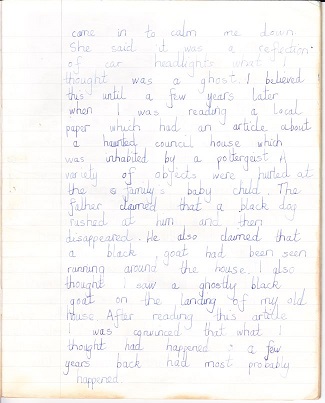 |
Although
it is difficult for me to recall a visual image of the 'apparition', I estimate
that the animal was 2.5-3.0 feet high; its fur was standing on end and it
seemed to be snarling or at least it was baring its teeth. It was this experience
that stimulated my interest in parapsychology and the paranormal. An account
of the effects that this experience has had upon my life was published in
the Exceptional Human Experiences (EHE) journal and the Journal of the American
Society for Psychical Research in 2000.
I should say that, as far as I know, I had not heard any similar stories prior to my experience. In fact, apart from reading a small section about animal ghosts in a children's ghost book when I was about 9-10 years of age and the case that I recalled from the newspaper, I was under the impression that reports of apparitions of black dogs were extremely rare. In 1993, since I had not come across much information on the subject, I decided to place an ad in 'The Psi Researcher' (published by the Society for Psychical Research) asking if anyone had could suggest possible references regarding animal ghosts and black dogs in particular. I received a number of valuable replies which pointed me in the direction of a number of useful references.
5. How are
these apparitions interpreted?
Reactions
to black dog apparitions vary from fear and aggression to acceptance and
friendship (Miller, 1984). Sometimes people try to stroke the dog (presumably
only if it appears friendly!) whilst at other times people have attempted to strike
it (Bord & Bord , 1985). Black dogs in Lincolnshire have often been
considered to be harmless and protective (Rudkin,
1935, 1938 cited by Miller, 1984). Indeed, it seems that the English black dog
has become a less fearsome and more friendly creature
over the last century (Brown, 1978 cited by Miller, 1984). Bord
& Bord (1985) suggest that "Working on the
basis of first-hand accounts there is rather more evidence that black dogs are
friendly (or at least harmless) than that they are dangerous. Indeed the dogs
are often positively helpful." (p.94). The
appearance of black dog apparitions has often been regarded as an omen of death
or bad luck or bad weather (Bord & Bord, 1985; Miller, 1984). Some appearances are good omens
but they are mostly believed to be bad omens, either communally or personally
(Brown, 1978).
So what explanations are there for these Black Dog encounters? In many ways, I think that hypnagogic/hypnopompic imagery (that which occurs as one is falling or waking from sleep) plus sleep paralysis (see Sherwood, 2002, 2012) provide a fairly good and parsimonious explanation for my own Black Dog experience. It did occur during the night around the time of sleep; the visual image of a large black dog-like animal, seen with eyes open, was fairly bizarre and very realistic and it did move towards me in a purposeful manner. The fact that I was also temporarily unable to move or make a sound throughout my experience seems remarkably similar to sleep paralysis. Sleep paralysis is also typically accompanied by an awareness of one's surroundings and often ends suddenly and spontaneously (see Sherwood, 2002, 2012).
However, part of me is still not convinced that this provides a sufficiently complete explanation for my experience or for those of many other people. Can it explain all of the descriptions of similar apparitions that other people have reported? No, not really. Most reports do not seem to have occurred around the time of sleep, though many have occurred at night. Some encounters have been witnessed by more than one person simultaneously. We do not have a good explanation for all of these experiences at present. We need to know much more about the different types of experiences, when and where they occur, in what circumstances and to whom, in order to fully explain them. We also need to encourage more researchers from different disciplines, particularly scientific ones, to investigate this phenomenon from different perspectives. A lot of valuable research has been conducted by folklorists but as Brown (1978, p. 45) pointed out, "[A]s folklorists we are not concerned with proving the actuality of supernatural phenomena. We are in the business to study beliefs, particularly patterns of belief."
A number of other normal, paranormal and supernatural explanations for Black Dog encounters have been suggested. One normal explanation is that reports were made up by parents to keep children away from restricted areas or going near rabid dogs and/or by grave-robbers to keep the public away from graveyards (see Miller, 1984). Alternatively, stories of black dogs might have encouraged certain societal norms, such as respect for the dead, and discouraged grave-robbing (Sikes, 1880; Thomas, 1978 cited by Miller, 1984). Although this theory might be able to explain some historical accounts, it is difficult to see how this could explain more recent reports. Another normal explanation is that the dogs are normal dogs or big cats that have been misperceived (e.g., Miller, 1984). Again this might account for some cases but this explanation cannot readily explain some of the more unusual features of the creatures' appearance/disappearance and behaviour. It has been suggested that the Black Dog might be purely hallucinatory and based upon personal or cultural archetypes (see Baynes, 1950; Jung, 1968, cited by Miller, 1984) or that one might learn about the local folklore surrounding the phenomenon and that this somehow shapes a later experience. Differences in personal archetypes might explain the unique features of some apparitions but it is difficult to establish whether or not such archetypes exist. However, how could this account for encounters observed by multiple witnesses who saw the same thing at the same time? In my own case, I am not sure that knowledge of local folklore could have created or influenced my experience as it was years later that I realised that the phenomenon has been reported quite often in Lincolnshire and East Anglia. However, I recognise that it is possible that I did hear about Black Dog phenomena prior to my own experience but that I have forgotten about this.
Another avenue that seems to be becoming more popular is the notion that apparitions in general might somehow be facilitated or created by interactions with environmental variables, such as infrasound (e.g. Parsons, 2012, 2015; Tandy & Lawrence, 1998; Tandy, 2000), electromagnetism or geomagnetism (e.g., Houran & Lange, 2001; Radin & Rebman, 1996) which might be particularly prominent in certain locations, such as ley lines (Bord & Bord, 1985; Miller, 1984). Some black dogs, such as the one reported to have visited Bungay and Blythburgh churches, have appeared during bad weather and it has been suggested that electrical storms might facilitate their appearance (Bord & Bord, 1985).
More paranormal explanations suggest that Black Dog apparitions are spirits of former working dogs or dogs that have suffered cruelty and/or violent deaths (Miller, 1984) or spirits of people, living or dead (e.g., Baynes, 1950, cited in Miller, 1984). However, many Black Dogs do not look like normal dogs and, even if they did, it would be difficult to establish whether they did share unique characteristics associated with known deceased animals. It has been suggested that, at critical times in a person's life, part of a person's personality may separate and rematerialise elsewhere in animal form (Baynes, 1950 cited by Miller, 1984). If Black Dogs are the spirits of people, then why and how do they take the form of a dog? Another paranormal/supernatural explanation that has been proposed is that they are real dogs that are possessed or are being influenced by the percipient (Brown, 1962, cited in Miller, 1984). However, it is not clear how this could account for some of the unusual features of Black Dogs' appearance and behaviour or how this control would become apparent or how it would be exercised. A final supernatural explanation is that the dogs are, or are associated with, the Devil or are a form assumed by witches or their familiars (e.g., Miller, 1984). At the present no single theory can adequately explain all features of Black Dog reports, though one must remember that there may be different explanations for different types of experience.
6. Some useful
references
|
|
Bayless, R. (1970). Animal Ghosts |
|
|
Bord, J. & Bord, C. (1985).
Alien Animals. London: Panther Books. An excellent starting point. |
|
|
Brown,
T. (1958). The Black Dog. Folk-Lore, 69, 175-192. A classic
article. |
|
|
Brown,
T. (1978). The Black Dog in English Folklore. In J. R. Porter & Russell
W. M. S. ‘Animals in Folklore’. |
|
|
Brown,
T. (1982). Devon Ghosts. Norwich: Jarrold &
Sons Ltd. |
| | Burchell, S. (2007). Phantom black dogs in Latin America. Wymeswold, England: Heart of Albion Press. |
|
|
Chambers,
R. (Ed.) (1879). Spectre Dogs. In, The Book of
Days Vol. 2 (pp. 433-436). Philadelphia, PA: J. P. Lippincott & Co. |
|
|
Dale-Green,
P. (1966). Dog. London: Rupert Hart-Davis. |
|
|
Eberhart, G. M. (1983). Monsters. London: Garland Publishing. |
|
|
Farson, D. (1978). The Hamlyn Book of Ghosts in fact and
fiction. London: Hamlyn. |
|
|
Houran, J., & Lange, R. (Eds.) (2001).
Hauntings and Poltergeists: Multidisciplinary Perspectives |
|
|
Huff,
C. (2002). Cave canem. Anomaly, 30, 2-22. |
|
|
Innes,
S. Beware of the Dog. The Unexplained, 86, 1710-1713. |
|
|
Innes,
S. Tracking down Black Dogs. The Unexplained, 87, 1730-1733. |
|
|
MacGregor, A. A. (1955). Black Shuck. In, The Ghost Book: Strange Hauntings in Britain (pp. 63-81). London: Robert Hale. |
|
|
McEwan, G. (1986). Mystery Animals of Britain and Ireland.
Unknown: Robert Hale. |
|
|
Michell, J. & Rickard, R. J. M. (1978). Phenomena: A Book of
Wonders. London: Thames and Hudson. |
|
|
Miles,
C. (1908). Experiments in thought transference. Journal of the Society for
Psychical Research, June, 243-262. |
|
|
Miller,
K. (1984). The Black Dog and other canine apparitions in Lincolnshire. In N.
Field & A. White (Eds.) ‘A Prospect of Lincolnshire’. Lincoln: Field
& White. |
|
|
Norman, M.
(2015). Black
Dog folklore. London: Troy Books. |
|
|
O’Donnell,
E. (1913). Animal Ghosts - Or, Animal Hauntings and the Hereafter |
| | Parsons, S. (2015). ‘Infrasound’. Psi Encyclopedia. London: The Society for Psychical Research. Retrieved 1 February 2023. |
| |
Parsons,
S. T. (2012). Infrasound and the paranormal. Journal of the Society for Psychical Research, 76(3), 150-174.
|
|
|
Radin, D. I., & Rebman, J. M. (1996).
Are phantasms fact or fantasy? A preliminary investigation of apparitions
evoked in the laboratory. Journal of the Society for Psychical Research,
61, 65-87. |
|
|
Reeve,
C. (1988). A Straunge & Terrible Wunder. Bungay, Suffolk: Morrow
& Co. |
|
|
Rudkin, E. H. (1938). The Black Dog. Folk-Lore, 49, 111-131. A classic
article. |
|
|
Sherwood,
S. (2002). Apparitions of Black Dogs. The Paranormal Review, 22, 3-6. |
|
|
Sherwood,
S. J. (2000). Black Dogs and English men. Exceptional Human Experience, 16,
226-230. |
|
|
Sherwood,
S. J. (2000). Black Dog apparitions. Journal of the American Society for
Psychical Research, 94, 151-164. |
|
|
Sherwood, S. J. (2002). Relationship between the hypnagogic/hypnopompic states and reports of anomalous experiences. Journal of Parapsychology, 66(2), 127-150. |
|
|
Sherwood,
S. J. (2004). The Black Dog of Uplyme. The
Paranormal Review, 32, 3-4. |
|
|
Sherwood,
S. J. (2005). A psychological approach to apparitions of Black Dogs. In B. Trubshaw (Ed.), Explore Phantom Black Dogs |
|
|
Sherwood,
S. J. (2006). Black Dogs of England. Australian Folklore, 21, 16-29. |
|
|
Sherwood,
S. J. (2010). Apparitions of Black Dogs. In M. D. Smith (Ed.), Anomalous Experiences: Essays from Parapsychological and Psychological Perspectives |
|
|
Sherwood, S. J. (2012).
A web survey of the content, sensory modalities and interpretation of
hypnagogic and hypnopompic experiences. Journal
of Parapsychology, 76(1),
27-55. |
|
|
Sherwood,
S. J., & Cousins, W. E. (2008). The Black Dog of Whitby and Kettleness. Anomaly: The Journal of Research into the
Paranormal [ASSAP], 42, 2-9. |
| | Tandy, V., & Lawrence, T. R. (1998). The ghost in the machine. Journal of the Society for Psychical Research, 62, 360-364. |
|
|
Tandy, V. (2000). Something in the cellar. Journal of the Society for Psychical Research, 64, 129-140. |
|
|
Trubshaw, B. (Ed.) (2005). Explore Phantom Black Dogs |
|
|
Waldron,
D., & Reeve, C. (2010). Shock! The Black Dog of Bungay: A Case Study in Local Folklore |
7. Other WWW sites
|
|
Shuck and
other Devil dog reports from the Paranormal Database |
|
|
|
|
|
|
|
|
|
|
|
|
|
|
|
|
|
Black Shuck distillery |
|
|
